1 of 24
Downloaded 19 times
![LŌĆÖORDINADOR I ELS SEUS COMPONENTS Esta presentaci├│n se ha realizado por Virgilio Marco. Profesor de Apoyo al ├ürea Pr├Īctica del IES Tiempos Modernos de Zaragoza. [email_address] www.iestiemposmodernos.com Traduit: ┤Ī▒╣▒▒¶┬Ę▒¶├Ł Cap├│](https://image.slidesharecdn.com/componentsordinador-110622124808-phpapp01/85/Components-de-l-ordinador-1-320.jpg)
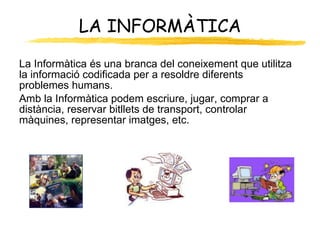
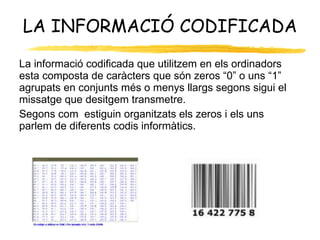
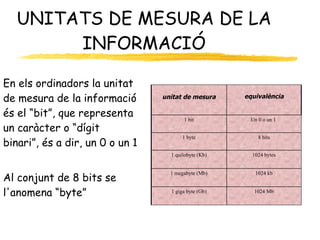
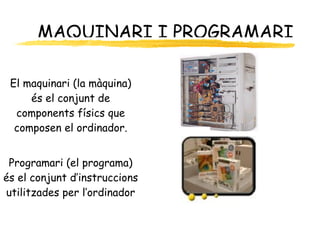

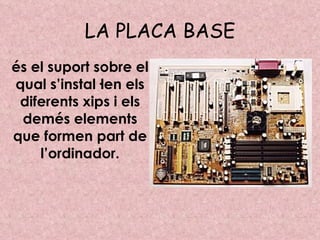

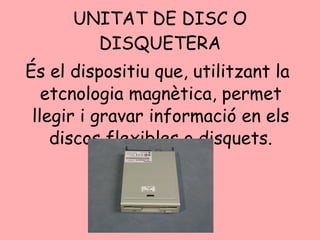
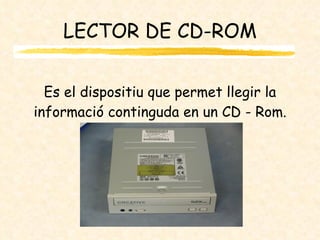
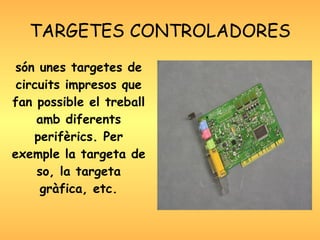


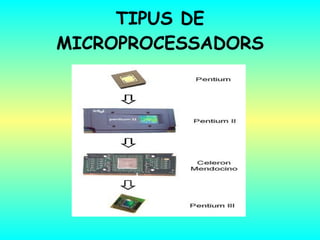
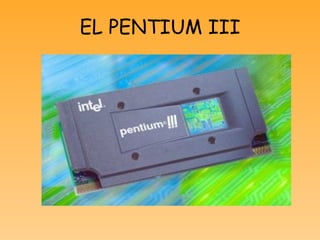
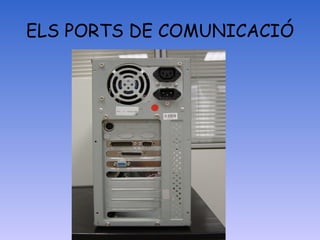

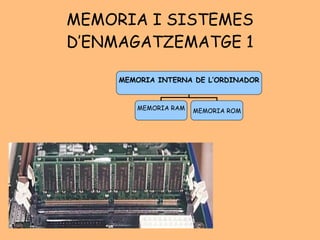
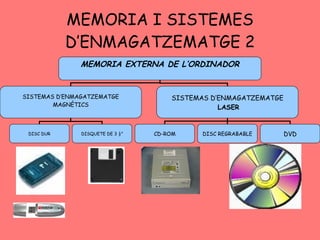
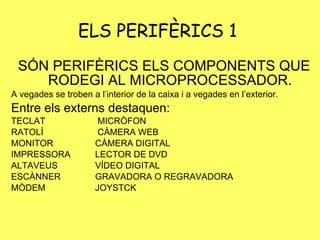

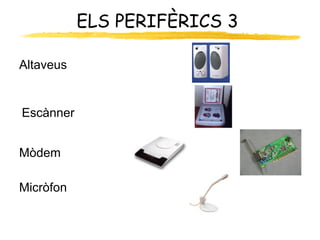
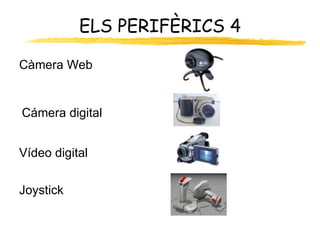

Ad
Recommended
Blu ray technology
Blu ray technologyGovind Raj
╠²
This document provides an overview of Blu-ray technology. It discusses that Blu-ray uses a blue laser and thinner disc structure to achieve over 5 times the storage capacity of DVDs, allowing for recording of high definition video. The format was developed by a consortium of electronics companies and supports playback of full length HD movies. Blu-ray has higher manufacturing costs than DVD initially but production costs are expected to decrease over time as the technology matures. It will likely replace DVD and provide the standard for high definition video storage going forward.Projecte la terra 3er Prim├Āria
Projecte la terra 3er Prim├ĀriaVictor Climent trinidad
╠²
Projecte sobre la terra, les seues parts, la representaci├│ i l'orientaci├│Concetti Di Base Di Informatica
Concetti Di Base Di InformaticaFrancesco Caliulo
╠²
Il documento tratta i fondamenti dell'informatica, inclusi concetti di hardware e software, con un focus sui vari tipi di computer e componenti hardware come la CPU e la memoria. Viene spiegato il ruolo del sistema operativo e i diversi tipi di software, oltre alle periferiche di input e output. Si conclude sottolineando l'importanza dell'alfabetizzazione informatica nella societ├Ā attuale.Programa consciencia fonologica
Programa consciencia fonologicaIrene Aliaga
╠²
AVALUACI├ō DE LA CONSCI├łNCIA FONOL├ÆGICA AMB ACTIVITATS PER EDATBlue Eyes Technology
Blue Eyes TechnologyColloquium
╠²
The document discusses the Blue Eyes technology, which aims to develop computers that can understand users' emotions, identity, and presence through techniques like facial recognition and speech recognition. The technology uses non-obtrusive sensing methods to gather physiological data from users to determine their emotional states. This would allow computers to interact more naturally with humans. Experimental results showed that measures of skin conductivity, heart rate, finger temperature, and mouse movements can reliably predict a user's emotional state. Future work aims to improve these techniques with smaller, less intrusive sensors.Rainbow technology
Rainbow technology Angad Kumar Singh
╠²
The document describes a new technology called Rainbow Technology that can store large amounts of data on ordinary paper. It works by encoding files into colored geometric shapes and symbols, representing data in combinations of colors instead of binary. A single sheet of paper can potentially store up to 450 GB of data using this method. The technology offers significant advantages over traditional storage methods like CDs and DVDs by storing more data at a much lower cost and in an environmentally friendly biodegradable format. However, data stored this way may be at risk for fading or loss over time.Pill cam 2
Pill cam 2Gowsalya Pandian
╠²
The pill camera was invented in the 1990s as a minimally invasive way to examine the digestive tract. It is a capsule-sized device containing a camera, lights, batteries, and transmitter. As it passes through the digestive system, it takes over 50,000 images that are transmitted to an external data recorder. The pill camera has revolutionized gastrointestinal diagnosis and detection of conditions like Crohn's disease with its painless, non-invasive procedure.Java ring Engg SEMINAR
Java ring Engg SEMINARrajdeepsatapathy
╠²
Java Ring is a stainless-steel ring that houses a microprocessor called an iButton, which contains 134KB RAM, 32KB ROM, and a Java virtual machine. It was introduced in 1998 to enable personalized services using information stored on the ring. Examples included a robot making coffee based on a user's preferences. While Java Rings are not widely used, similar wearable devices could be used for applications like automatically adjusting vehicle settings based on the driver's stored preferences.Rainbow technology-ppt
Rainbow technology-pptRajesh Roky
╠²
The document describes a proposed new data storage technology called "Rainbow Technology" that claims to be able to store up to 450 GB of data on an ordinary sheet of paper. It would represent data using colored geometric shapes rather than binary and could store around 2.7 GB per square inch when printed at high resolution. However, experts are skeptical because the claimed storage densities would require unprecedented compression or capabilities beyond current printing and scanning technologies. If proven, Rainbow Technology could provide an extremely low-cost and environmentally friendly alternative to DVDs and hard drives.La br├║ixola
La br├║ixolaJoan Picas i Casanovas
╠²
Presentaci├│ sobre la br├║ixola, les seves parts i els seus usos.Project loon.ppt
Project loon.pptSahil Ronaldo
╠²
Project Loon is Google's initiative to provide internet access to rural and remote areas using high-altitude balloons. The balloons float in the stratosphere and work together to connect people on the ground. In 2013, Google launched a pilot test involving 30 balloons over New Zealand that successfully provided internet access to 50 test users. Project Loon aims to continue expanding its pilot program to create continuous connectivity around the 40th parallel south latitude using balloons and renewable energy sources.Artificial passenger abstract
Artificial passenger abstractyasmeen123
╠²
An artificial passenger system is proposed to ensure drivers stay alert. It would converse with drivers using speech generation and ask questions to check alertness. A camera and voice analysis could also monitor for drowsiness, and measures like opening windows or spraying water may be used if needed. Developing voice-controlled telematics systems can reduce distraction compared to manual controls. Allowing natural speech queries makes it easier for drivers to interact without remembering complex syntax. However, full natural language understanding requires significant computer resources not available in vehicles. To address this, natural language components could be located on remote servers or downsized to run locally on embedded chips in vehicles. Researchers are developing a reduced natural language understanding variant that can run on limited resourceSmart quill ppt
Smart quill pptRajendra Dangwal
╠²
The document presents information about Smart Quill, including its introduction, features, working, applications, advantages, and disadvantages. Smart Quill allows for digital note taking and annotations. It has features like handwriting recognition, searchability, and collaboration. Some advantages are that it replaces physical notebooks and allows notes to be shared, while disadvantages include an internet connection being required and a learning curve for the technology.Plastic memory
Plastic memoryRajendra Dangwal
╠²
The document discusses a novel plastic memory technology developed by scientists at HP Labs and Princeton University, which offers high-density data storage in a small size and at a lower cost than traditional silicon-based memory. The plastic memory utilizes a conducting polymer to create a one-time writable storage solution that can achieve data transfer speeds of 2-10 MB/s for reading and 1-4 MB/s for writing. This technology combines characteristics of both CDs and conventional memory chips, being cost-effective and energy-efficient while maintaining data even when powered off.Fluoroscent multilayer disc
Fluoroscent multilayer discTheprince Mahi
╠²
Fluorescent Multilayer Disk (FMD) technology allows for over 100 layers in a disk by using fluorescent materials that emit different wavelengths of light for each layer. This overcomes limitations of reflective DVDs which degrade after only a few layers. FMD prototypes demonstrated 50GB storage using red lasers, with plans for 140GB using red lasers and over 1TB using blue lasers. FMD works by filling pits with fluorescent materials that convert laser light to a distinct emitted wavelength, allowing layers to be read through the transparent disk. The main limitation is thickness, not interference like in DVDs.Nightvision
NightvisionGagandeep Singh
╠²
This document discusses the history and development of night vision technology from its origins in WWII to modern applications. It describes how early night vision devices used searchlights but had disadvantages, leading to advancements like image intensification tubes and thermal imaging. The document outlines the generations of night vision and how they provide improved amplification and resolution. It discusses uses of night vision in the military, law enforcement, automobiles and other areas, concluding that night vision has come a long way from its military origins to help people today.smart quill pen
smart quill penranjith12
╠²
The Smart Quill is an innovative pen that captures handwritten text and transfers it to a computer, utilizing accelerometer technology and handwriting recognition software for accurate transcription. It features a display screen, security through handwriting verification, and can store up to 10 pages of notes, offering a convenient alternative to traditional keyboards. While it has advantages like portability and power efficiency, it also faces challenges such as errors from accelerometers and being less suitable for individuals with hand tremors.BLUE EYES TECHNOLOGY
BLUE EYES TECHNOLOGYShehin Pm
╠²
This document describes Blue Eyes technology, which aims to give computers human-like perceptual abilities. It discusses the hardware, software, and technologies used to monitor users' physical and emotional states through sensors. The goal is to help computers understand users and interact in a more natural way. Blue Eyes uses devices like an emotion mouse and eye tracking to collect data on users, which is then analyzed to determine their state and needs. The information could help computers serve users better or ensure safety in environments like control rooms.Presentaci├│ lupa binocular m├®s c├Āmera moticam
Presentaci├│ lupa binocular m├®s c├Āmera moticamjchivite1
╠²
Descripci├│ del funcionament, parts i ├║s.Partes del ordenadorrevistapabloneruda
╠²
El documento describe los componentes principales de un ordenador y sus perif├®ricos, incluyendo la placa base, procesador y memoria del ordenador, as├Ł como perif├®ricos de entrada como teclados y ratones, perif├®ricos de salida como monitores e impresoras, perif├®ricos de comunicaci├│n como m├│dems y routers, y dispositivos de almacenamiento como discos duros, CDs y DVDs.Presentaci├│ Institut COMTE DE RIUS 2011
Presentaci├│ Institut COMTE DE RIUS 2011Comte de Rius Institut
╠²
Presentaci├│ Institut COMTE DE RIUS 2011More Related Content
What's hot (20)
Blue Eyes Technology
Blue Eyes TechnologyColloquium
╠²
The document discusses the Blue Eyes technology, which aims to develop computers that can understand users' emotions, identity, and presence through techniques like facial recognition and speech recognition. The technology uses non-obtrusive sensing methods to gather physiological data from users to determine their emotional states. This would allow computers to interact more naturally with humans. Experimental results showed that measures of skin conductivity, heart rate, finger temperature, and mouse movements can reliably predict a user's emotional state. Future work aims to improve these techniques with smaller, less intrusive sensors.Rainbow technology
Rainbow technology Angad Kumar Singh
╠²
The document describes a new technology called Rainbow Technology that can store large amounts of data on ordinary paper. It works by encoding files into colored geometric shapes and symbols, representing data in combinations of colors instead of binary. A single sheet of paper can potentially store up to 450 GB of data using this method. The technology offers significant advantages over traditional storage methods like CDs and DVDs by storing more data at a much lower cost and in an environmentally friendly biodegradable format. However, data stored this way may be at risk for fading or loss over time.Pill cam 2
Pill cam 2Gowsalya Pandian
╠²
The pill camera was invented in the 1990s as a minimally invasive way to examine the digestive tract. It is a capsule-sized device containing a camera, lights, batteries, and transmitter. As it passes through the digestive system, it takes over 50,000 images that are transmitted to an external data recorder. The pill camera has revolutionized gastrointestinal diagnosis and detection of conditions like Crohn's disease with its painless, non-invasive procedure.Java ring Engg SEMINAR
Java ring Engg SEMINARrajdeepsatapathy
╠²
Java Ring is a stainless-steel ring that houses a microprocessor called an iButton, which contains 134KB RAM, 32KB ROM, and a Java virtual machine. It was introduced in 1998 to enable personalized services using information stored on the ring. Examples included a robot making coffee based on a user's preferences. While Java Rings are not widely used, similar wearable devices could be used for applications like automatically adjusting vehicle settings based on the driver's stored preferences.Rainbow technology-ppt
Rainbow technology-pptRajesh Roky
╠²
The document describes a proposed new data storage technology called "Rainbow Technology" that claims to be able to store up to 450 GB of data on an ordinary sheet of paper. It would represent data using colored geometric shapes rather than binary and could store around 2.7 GB per square inch when printed at high resolution. However, experts are skeptical because the claimed storage densities would require unprecedented compression or capabilities beyond current printing and scanning technologies. If proven, Rainbow Technology could provide an extremely low-cost and environmentally friendly alternative to DVDs and hard drives.La br├║ixola
La br├║ixolaJoan Picas i Casanovas
╠²
Presentaci├│ sobre la br├║ixola, les seves parts i els seus usos.Project loon.ppt
Project loon.pptSahil Ronaldo
╠²
Project Loon is Google's initiative to provide internet access to rural and remote areas using high-altitude balloons. The balloons float in the stratosphere and work together to connect people on the ground. In 2013, Google launched a pilot test involving 30 balloons over New Zealand that successfully provided internet access to 50 test users. Project Loon aims to continue expanding its pilot program to create continuous connectivity around the 40th parallel south latitude using balloons and renewable energy sources.Artificial passenger abstract
Artificial passenger abstractyasmeen123
╠²
An artificial passenger system is proposed to ensure drivers stay alert. It would converse with drivers using speech generation and ask questions to check alertness. A camera and voice analysis could also monitor for drowsiness, and measures like opening windows or spraying water may be used if needed. Developing voice-controlled telematics systems can reduce distraction compared to manual controls. Allowing natural speech queries makes it easier for drivers to interact without remembering complex syntax. However, full natural language understanding requires significant computer resources not available in vehicles. To address this, natural language components could be located on remote servers or downsized to run locally on embedded chips in vehicles. Researchers are developing a reduced natural language understanding variant that can run on limited resourceSmart quill ppt
Smart quill pptRajendra Dangwal
╠²
The document presents information about Smart Quill, including its introduction, features, working, applications, advantages, and disadvantages. Smart Quill allows for digital note taking and annotations. It has features like handwriting recognition, searchability, and collaboration. Some advantages are that it replaces physical notebooks and allows notes to be shared, while disadvantages include an internet connection being required and a learning curve for the technology.Plastic memory
Plastic memoryRajendra Dangwal
╠²
The document discusses a novel plastic memory technology developed by scientists at HP Labs and Princeton University, which offers high-density data storage in a small size and at a lower cost than traditional silicon-based memory. The plastic memory utilizes a conducting polymer to create a one-time writable storage solution that can achieve data transfer speeds of 2-10 MB/s for reading and 1-4 MB/s for writing. This technology combines characteristics of both CDs and conventional memory chips, being cost-effective and energy-efficient while maintaining data even when powered off.Fluoroscent multilayer disc
Fluoroscent multilayer discTheprince Mahi
╠²
Fluorescent Multilayer Disk (FMD) technology allows for over 100 layers in a disk by using fluorescent materials that emit different wavelengths of light for each layer. This overcomes limitations of reflective DVDs which degrade after only a few layers. FMD prototypes demonstrated 50GB storage using red lasers, with plans for 140GB using red lasers and over 1TB using blue lasers. FMD works by filling pits with fluorescent materials that convert laser light to a distinct emitted wavelength, allowing layers to be read through the transparent disk. The main limitation is thickness, not interference like in DVDs.Nightvision
NightvisionGagandeep Singh
╠²
This document discusses the history and development of night vision technology from its origins in WWII to modern applications. It describes how early night vision devices used searchlights but had disadvantages, leading to advancements like image intensification tubes and thermal imaging. The document outlines the generations of night vision and how they provide improved amplification and resolution. It discusses uses of night vision in the military, law enforcement, automobiles and other areas, concluding that night vision has come a long way from its military origins to help people today.smart quill pen
smart quill penranjith12
╠²
The Smart Quill is an innovative pen that captures handwritten text and transfers it to a computer, utilizing accelerometer technology and handwriting recognition software for accurate transcription. It features a display screen, security through handwriting verification, and can store up to 10 pages of notes, offering a convenient alternative to traditional keyboards. While it has advantages like portability and power efficiency, it also faces challenges such as errors from accelerometers and being less suitable for individuals with hand tremors.BLUE EYES TECHNOLOGY
BLUE EYES TECHNOLOGYShehin Pm
╠²
This document describes Blue Eyes technology, which aims to give computers human-like perceptual abilities. It discusses the hardware, software, and technologies used to monitor users' physical and emotional states through sensors. The goal is to help computers understand users and interact in a more natural way. Blue Eyes uses devices like an emotion mouse and eye tracking to collect data on users, which is then analyzed to determine their state and needs. The information could help computers serve users better or ensure safety in environments like control rooms.Presentaci├│ lupa binocular m├®s c├Āmera moticam
Presentaci├│ lupa binocular m├®s c├Āmera moticamjchivite1
╠²
Descripci├│ del funcionament, parts i ├║s.Viewers also liked (14)
Partes del ordenadorrevistapabloneruda
╠²
El documento describe los componentes principales de un ordenador y sus perif├®ricos, incluyendo la placa base, procesador y memoria del ordenador, as├Ł como perif├®ricos de entrada como teclados y ratones, perif├®ricos de salida como monitores e impresoras, perif├®ricos de comunicaci├│n como m├│dems y routers, y dispositivos de almacenamiento como discos duros, CDs y DVDs.Presentaci├│ Institut COMTE DE RIUS 2011
Presentaci├│ Institut COMTE DE RIUS 2011Comte de Rius Institut
╠²
Presentaci├│ Institut COMTE DE RIUS 2011Jornada IOC. Nuevos mediosMiguel Angel Muras
╠²
El documento analiza las nuevas tecnolog├Łas en el ├Īmbito de la educaci├│n, enfoc├Īndose en el uso de dispositivos m├│viles, simuladores y juegos serios que transforman los procesos de ense├▒anza. Tambi├®n se menciona la creciente importancia de los dispositivos t├Īctiles y la realidad aumentada como herramientas educativas. En general, propone una visi├│n de c├│mo estas innovaciones est├Īn cambiando la interacci├│n de los estudiantes con los contenidos educativos.Tutorial para crear un blog con Bloggercascadas
╠²
Este documento es un tutorial detallado sobre c├│mo crear y gestionar un blog utilizando la plataforma Blogger, abarcando desde la creaci├│n de una cuenta de Gmail hasta la inserci├│n de elementos multimedia y la personalizaci├│n del dise├▒o del blog. Se describen las partes, estructuras y configuraciones b├Īsicas de un blog, as├Ł como usos avanzados y consejos para mejorar la interacci├│n con los lectores. Adem├Īs, proporciona informaci├│n sobre estad├Łsticas y la adici├│n de gadgets para enriquecer la experiencia del usuario.Termodinamica aplicada a sistemas vivosEDWIN POMATANTA
╠²
El documento habla sobre conceptos de termodin├Īmica como calor, temperatura, escalas de temperatura, sistemas termodin├Īmicos, leyes de la termodin├Īmica, entre otros. Explica que el calor es la energ├Ła del movimiento molecular mientras que la temperatura es una medida de la energ├Ła molecular promedio. Tambi├®n define conceptos como capacidad calor├Łfica, entalp├Ła y las diferentes formas de transferir calor como conducci├│n, convecci├│n y radiaci├│n.La memoriarssk
╠²
El documento resume los principales antecedentes e investigaciones sobre la memoria desde finales del siglo XIX hasta la actualidad. Aborda temas como los primeros estudios de Ebbinghaus y Bartlett, los l├Łmites de la memoria a corto plazo seg├║n Miller, los componentes y sistemas de memoria, los mecanismos biol├│gicos que subyacen a la formaci├│n de recuerdos, y trastornos como el alzh├®imer.Ad
Similar to Components de l'ordinador (20)
Components de l'ordinador
Components de l'ordinadormireiiaa96
╠²
Aqui teniu un power point sobre els diferents components d'un ordinador.Ad
More from ┤Ī▒╣▒▒¶┬Ę▒¶├Ł (20)
Som Energia: El cooperativisme energ├©tic: la resposta ciutadana
Som Energia: El cooperativisme energ├©tic: la resposta ciutadana┤Ī▒╣▒▒¶┬Ę▒¶├Ł
╠²
12 dŌĆÖabril del 2013
Alexandre Duran i Grant
Som Energia Mallorca
Som Energia: Autoconsum fotovoltaic
Som Energia: Autoconsum fotovoltaic┤Ī▒╣▒▒¶┬Ę▒¶├Ł
╠²
Cooperativa de producci├│ i consum dŌĆÖenergia verda com a eina per canviar el model energ├©tic
Som Energia: 1r Congr├®s d'Energies Renovables i Sostenibilitat en Territoris ...
Som Energia: 1r Congr├®s d'Energies Renovables i Sostenibilitat en Territoris ...┤Ī▒╣▒▒¶┬Ę▒¶├Ł
╠²
Cooperativa de producci├│ i consum dŌĆÖenergia verda com a eina per canviar el model energ├©tic
1r Congr├®s d'Energies Renovables i Sostenibilitat en Territoris Insulars
Recinte firal de Menorca, 11 a 14 d'abril de 2013▒╩▓į▒│▄│Š├Ā│┘Š▒│”▓╣┤Ī▒╣▒▒¶┬Ę▒¶├Ł
╠²
El documento aborda el tema de la neum├Ītica en el contexto de un curso de bachillerato en tecnolog├Ła industrial. Se discuten compresores, cilindros neum├Īticos, v├Īlvulas y su dise├▒o, as├Ł como la creaci├│n de circuitos neum├Īticos y diversos ejemplos de aplicaci├│n. Tambi├®n se incluyen ejercicios pr├Īcticos para reforzar el aprendizaje.Hay alternativas┤Ī▒╣▒▒¶┬Ę▒¶├Ł
╠²
Este documento presenta un pr├│logo de Noam Chomsky y una introducci├│n a un libro titulado "Hay alternativas". El pr├│logo describe c├│mo el poder se ha concentrado en manos de una peque├▒a fracci├│n del 1% m├Īs rico a nivel mundial, en detrimento de la mayor├Ła de la poblaci├│n. La introducci├│n argumenta que existen alternativas viables a las pol├Łticas neoliberales de austeridad que promueven los gobiernos y que estas alternativas se basan en evidencia cient├Łfica.Vaga
Vaga┤Ī▒╣▒▒¶┬Ę▒¶├Ł
╠²
Aquest full el volen entregar els sindicats a la conselleria per demanar que el doblers que ens descomptin als vaguistes vagi al propi centre.
Per demanar que no hi quedi!Gnu ubuntu-facil-v4┤Ī▒╣▒▒¶┬Ę▒¶├Ł
╠²
El documento proporciona una lista de los comandos m├Īs usados en GNU/Linux y Unix, junto con una breve descripci├│n de la funci├│n de cada comando y ejemplos de su uso. Algunos de los comandos m├Īs comunes incluyen man, cd, ls, cat, mkdir, rm, less, date, ps y top. El documento tambi├®n incluye informaci├│n de contacto sobre la Fundaci├│n C├│digo Libre, que public├│ el documento, y nota sobre la licencia bajo la cual el contenido se distribuye.Ubunturef(esp) Comandos┤Ī▒╣▒▒¶┬Ę▒¶├Ł
╠²
Este documento proporciona informaci├│n sobre comandos y herramientas ├║tiles en Ubuntu, incluyendo c├│mo ejecutar comandos como root, configurar la red, actualizar y gestionar paquetes, administrar el escritorio y pantalla, controlar servicios del sistema, y usar el cortafuegos ufw. Tambi├®n lista aplicaciones comunes como nautilus, dolphin, y kate, y proporciona detalles sobre c├│mo recuperar el sistema y obtener informaci├│n b├Īsica sobre la versi├│n de Ubuntu.Softlibre enriquecido┤Ī▒╣▒▒¶┬Ę▒¶├Ł
╠²
Este documento presenta el Manifiesto GNU de Richard Stallman, en el que:
1) Explica el proyecto GNU y su objetivo de crear un sistema operativo compatible con Unix que sea software libre.
2) Define qu├® es software libre y por qu├® es importante que el software no tenga propietarios.
3) Describe los or├Łgenes, logros y retos futuros del proyecto GNU, incluyendo el desarrollo del n├║cleo Linux y su combinaci├│n con el sistema GNU para crear GNU/Linux.Manual desobediencia┤Ī▒╣▒▒¶┬Ę▒¶├Ł
╠²
Este documento proporciona instrucciones para evadir la censura de sitios web bajo la Ley Sinde en Espa├▒a. Explica que cambiar los servidores DNS a opciones fuera de Espa├▒a evita que el gobierno bloquee sitios web. Tambi├®n recomienda usar proxies, Tor, VPN y herramientas de copia de seguridad para proteger el acceso a la informaci├│n. El objetivo es demostrar que la censura en Internet es ineficaz y que los usuarios siempre encontrar├Īn la manera de acceder al contenido que deseen.Ebook openoffice 3-writer-calc-impress┤Ī▒╣▒▒¶┬Ę▒¶├Ł
╠²
Este documento presenta una introducci├│n al software libre OpenOffice, incluyendo:
1) Las razones para usar OpenOffice, como que es gratuito, funciona en m├║ltiples sistemas operativos, y tiene una licencia que permite compartir y modificar el software.
2) C├│mo descargar e instalar OpenOffice desde su p├Īgina web.
3) Una breve descripci├│n de las principales aplicaciones incluidas en OpenOffice como Writer para procesamiento de textos, Calc para hojas de c├Īlculo, e Impress para presentaciones.Cap09. Introducci├│n a Linux Otras tareas elementales┤Ī▒╣▒▒¶┬Ę▒¶├Ł
╠²
Este documento proporciona instrucciones sobre c├│mo realizar varias tareas b├Īsicas en Linux, como comprimir y descomprimir archivos, grabar CDs/DVDs, reproducir audio y video, escanear documentos, y acceder a c├Īmaras digitales. Explica herramientas como K3b para grabar CDs/DVDs, aplicaciones para reproducir audio y video como Totem y Mplayer, y XSane para escanear. Tambi├®n incluye ejemplos y actividades para que el lector practique estas tareas.Cap04.Introducci├│n a Linux El entorno de trabajo en Ubuntu┤Ī▒╣▒▒¶┬Ę▒¶├Ł
╠²
Este documento proporciona una introducci├│n al entorno de trabajo en Ubuntu. Explica los elementos b├Īsicos como el teclado, rat├│n, escritorio, ventanas, lanzadores, personalizaci├│n del escritorio, paneles y selecci├│n de idioma. Describe las funciones y usos de cada uno de estos componentes para ayudar a los usuarios a familiarizarse con la interfaz de Ubuntu.Cap07.Introducci├│n a Linux Aplicaciones de red┤Ī▒╣▒▒¶┬Ę▒¶├Ł
╠²
Este documento proporciona una introducci├│n a las aplicaciones de red m├Īs populares en Linux, incluyendo el navegador Firefox, Evolution para correo y calendario, FTP con gFTP, y mensajer├Ła instant├Īnea con Gaim. Explica funciones clave como navegar entre pesta├▒as, bloquear ventanas emergentes, usar marcadores, y configurar cuentas de correo en Evolution.Recently uploaded (9)
Places assigandes curs 25-26 escola Roser Capdevila
Places assigandes curs 25-26 escola Roser CapdevilaEscolaRoserCapdevila18
╠²
El llistat de places assignades per la matr├Łcula del curs 25-26, de l'escola Roser Capdevila de Sant Joan Desp├ŁINFORME_ASSIGNADES_INFORME_ASSIGNADESescolaernestlluch.pdf
INFORME_ASSIGNADES_INFORME_ASSIGNADESescolaernestlluch.pdfErnest Lluch
╠²
ALUMNES ASSIGNATS
PREINSCRIPCI├ō 25/2620250616+Ėķ▒▒╣Š▒▓§│┘▓╣+│ó▓╣+│šŠ▒▓į▓Ō┤Ū│┘▓╣+-+ĘĪ▓§│”┤Ū▒¶▓╣+│¦▓╣▓į│┘+│šŠ▒│”▒▓į├¦+╗Õ▒+▓č┤Ū▒¶▒¶▒│┘+╗Õ▒▒¶+│š▓╣▒¶▒¶├©▓§+-+▒╗ÕŠ▒│”Š▒...
20250616+Ėķ▒▒╣Š▒▓§│┘▓╣+│ó▓╣+│šŠ▒▓į▓Ō┤Ū│┘▓╣+-+ĘĪ▓§│”┤Ū▒¶▓╣+│¦▓╣▓į│┘+│šŠ▒│”▒▓į├¦+╗Õ▒+▓č┤Ū▒¶▒¶▒│┘+╗Õ▒▒¶+│š▓╣▒¶▒¶├©▓§+-+▒╗ÕŠ▒│”Š▒...montsefarell1
╠²
Escola Sant Vicen├¦ de Mollet del Vall├©sDOSSIER ESTIU A1INICIAL! Us presento un dossier que haur├Ās de completar dura...
DOSSIER ESTIU A1INICIAL! Us presento un dossier que haur├Ās de completar dura...JosepRamonGregoriMuo
╠²
Benvolguts alumnes,
Us presento un dossier que haur├Ās de completar durant les vostres vacances dŌĆÖestiu i entregar-lo, ben fet i ben presentat, al setembre. La idea ├®s que practiqueu i no oblideu vocabulari que hem treballat durant el curs.
Us desitjo que passeu i gaudiu dŌĆÖunes bones vacances dŌĆÖestiu.
Ens tornarem a veure al 8 de setembre quan comencen les classes de nou!
INFORME_LLISTA_ESPERA_OME_LLISTA_ESPERAescolaernestlluch.pdf
INFORME_LLISTA_ESPERA_OME_LLISTA_ESPERAescolaernestlluch.pdfErnest Lluch
╠²
LLISTA D'ESPERA
PREINSCRIPCI├ō 25/26Informe Llista d'espera Escola Roser Capdevila
Informe Llista d'espera Escola Roser CapdevilaEscolaRoserCapdevila18
╠²
Publicaci├│ de la llista d'espera per la matr├Łcula del curs 25-26 de l'escola Roser Capdevila de Sant Joan Desp├Ł.20250616+Ėķ▒▒╣Š▒▓§│┘▓╣+│ó▓╣+│šŠ▒▓į▓Ō┤Ū│┘▓╣+-+ĘĪ▓§│”┤Ū▒¶▓╣+│¦▓╣▓į│┘+│šŠ▒│”▒▓į├¦+╗Õ▒+▓č┤Ū▒¶▒¶▒│┘+╗Õ▒▒¶+│š▓╣▒¶▒¶├©▓§+-+▒╗ÕŠ▒│”Š▒...
20250616+Ėķ▒▒╣Š▒▓§│┘▓╣+│ó▓╣+│šŠ▒▓į▓Ō┤Ū│┘▓╣+-+ĘĪ▓§│”┤Ū▒¶▓╣+│¦▓╣▓į│┘+│šŠ▒│”▒▓į├¦+╗Õ▒+▓č┤Ū▒¶▒¶▒│┘+╗Õ▒▒¶+│š▓╣▒¶▒¶├©▓§+-+▒╗ÕŠ▒│”Š▒...montsefarell1
╠²
DOSSIER ESTIU A1INICIAL! Us presento un dossier que haur├Ās de completar dura...
DOSSIER ESTIU A1INICIAL! Us presento un dossier que haur├Ās de completar dura...JosepRamonGregoriMuo
╠²
Components de l'ordinador
- 1. LŌĆÖORDINADOR I ELS SEUS COMPONENTS Esta presentaci├│n se ha realizado por Virgilio Marco. Profesor de Apoyo al ├ürea Pr├Īctica del IES Tiempos Modernos de Zaragoza. [email_address] www.iestiemposmodernos.com Traduit: ┤Ī▒╣▒▒¶┬Ę▒¶├Ł Cap├│
- 2. LA INFORM├ĆTICA La Inform├Ātica ├®s una branca del coneixement que utilitza la informaci├│ codificada per a resoldre diferents problemes humans. Amb la Inform├Ātica podem escriure, jugar, comprar a dist├Āncia, reservar bitllets de transport, controlar m├Āquines, representar imatges, etc.
- 3. LA INFORMACI├ō CODIFICADA La informaci├│ codificada que utilitzem en els ordinadors esta composta de car├Ācters que s├│n zeros ŌĆ£0ŌĆØ o uns ŌĆ£1ŌĆØ agrupats en conjunts m├®s o menys llargs segons sigui el missatge que desitgem transmetre. Segons com estiguin organitzats els zeros i els uns parlem de diferents codis inform├Ātics.
- 4. UNITATS DE MESURA DE LA INFORMACI├ō En els ordinadors la unitat de mesura de la informaci├│ ├®s el ŌĆ£bitŌĆØ, que representa un car├Ācter o ŌĆ£d├Łgit binariŌĆØ, ├®s a dir, un 0 o un 1 Al conjunt de 8 bits se l'anomena ŌĆ£byteŌĆØ Un 0 o un 1 1 bit 1024 Mb 1 giga byte (Gb) 1024 kb 1 megabyte (Mb) 1024 bytes 1 quilobyte (Kb) 8 bits 1 byte equival├©ncia unitat de mesura
- 5. MAQUINARI I PROGRAMARI El maquinari (la m├Āquina) ├®s el conjunt de components f├Łsics que composen el ordinador. Programari (el programa) ├®s el conjunt dŌĆÖinstruccions utilitzades per lŌĆÖordinador
- 6. UNA MIRADA A LŌĆÖINTERIOR DŌĆÖUN PC AQUEST S├ōN ELS PRINCIPALS COMPONENTS INTERNS: PLACA BASE
- 7. DISC DUR
- 10. UNITAT DE DISC O DISQUETERA
- 12. LA PLACA BASE ├®s el suport sobre el qual sŌĆÖinstal┬Ęlen els diferents xips i els dem├®s elements que formen part de lŌĆÖordinador.
- 13. DISC DUR ├ēs un dispositiu dŌĆÖemmagatzematge de dades, que utilitza etcnologia magn├©tica.
- 14. UNITAT DE DISC O DISQUETERA ├ēs el dispositiu que, utilitzant la etcnologia magn├©tica, permet llegir i gravar informaci├│ en els discos flexibles o disquets.
- 15. LECTOR DE CD-ROM Es el dispositiu que permet llegir la informaci├│ continguda en un CD - Rom.
- 16. TARGETES CONTROLADORES s├│n unes targetes de circuits impresos que fan possible el treball amb diferents perif├©rics. Per exemple la targeta de so, la targeta gr├Āfica, etc.
- 17. FONT DŌĆÖALIMENTACI├ō SŌĆÖencarrega de transformar la tensi├│ que arriba de la xarxa el├©ctrica (220 V) a 3,3 o 5 V, depenent del tipus dŌĆÖordinador de que es tracti.
- 18. EL MICROPROCESSADOR El microprocessador ├®s la part m├®s important de lŌĆÖordinador perqu├© cont├® la Unitat Central de Proc├®s (CPU) Les seves funcions s├│n: Processar les instruccions Calcular Manejar el flux dŌĆÖinformaci├│
- 20. EL PENTIUM III
- 21. ELS PORTS DE ░õ░┐▓č▒½▒Ę▒§░õ┤Ī░õ▒§═č
- 22. EL PORT DE ░õ░┐▓č▒½▒Ę▒§░õ┤Ī░õ▒§═č USB
- 23. MEMORIA I SISTEMES DŌĆÖENMAGATZEMATGE 1 MEMORIA INTERNA DE LŌĆÖORDINADOR MEMORIA RAM MEMORIA ROM
- 24. MEMORIA I SISTEMES DŌĆÖENMAGATZEMATGE 2 MEMORIA EXTERNA DE LŌĆÖORDINADOR SISTEMAS DŌĆÖENMAGATZEMATGE MAGN├łTICS SISTEMAS DŌĆÖENMAGATZEMATGE LASER DISC DUR DISQUETE DE 3 ┬ĮŌĆØ CD-ROM DISC REGRABABLE DVD
- 25. ELS PERIF├łRICS 1 S├ōN PERIF├łRICS ELS COMPONENTS QUE RODEGI AL MICROPROCESSADOR. A vegades se troben a lŌĆÖinterior de la caixa i a vegades en lŌĆÖexterior. Entre els externs destaquen: TECLAT MICR├ÆFON
- 26. RATOL├Ź C├ĆMERA WEB
- 28. IMPRESSORA LECTOR DE DVD
- 29. ALTAVEUS V├ŹDEO DIGITAL
- 30. ESC├ĆNNER GRAVADORA O REGRAVADORA
- 31. ▓č├ÆČ┘ĘĪ▓č JOYSTCK
- 32. ELS PERIF├łRICS 2 Teclat Ratol├Ł Monitor Impressora
- 33. ELS PERIF├łRICS 3 Altaveus Esc├Ānner M├▓dem Micr├▓fon
- 34. ELS PERIF├łRICS 4 C├Āmera Web C├Īmera digital V├Łdeo digital Joystick
- 35. DISPOSITUS DŌĆÖENTRADA I DE SORTIDA s├│n dispositius dŌĆÖentrada els que recullen dades i els introdueixen al microprocessador.
- 36. s├│n dispositius de sortida els que reben les dades que treu lŌĆÖordinador
- 37. Certs dispositius s├│n a la vegada dŌĆÖentrada i de sortida perqu├© poden rebre dades del microprocesador o tamb├® introduir-les
